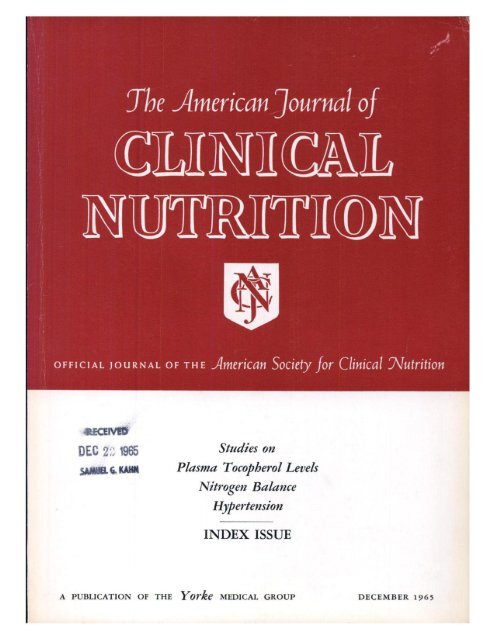膳食蛋白质和氨基酸需要量的评价:系统综述
IF 6.5
1区 医学
Q1 NUTRITION & DIETETICS
引用次数: 0
摘要
蛋白质摄入量是由膳食参考摄入量设定的,该参考摄入量于2005年发布,此后就没有更新过。目的评价健康人群按生命阶段和性别对每日平均膳食蛋白质和个体必需氨基酸需要量的要求。方法检索2000年1月至2024年5月Medline、EMBASE、AGRICOLA和Scopus的文献。两位审稿人使用预先确定的纳入/排除标准独立筛选标题、摘要和全文出版物。我们提取数据,评估偏倚风险(RoB),定性地综合低至中等偏倚风险研究的结果,并评估支持结论的证据的强度。结果:我们纳入了11408项研究,其中68篇报道了66项独特研究的文章符合本综述的条件,45篇被评估为低或中度RoB。6项研究调查了婴儿对异亮氨酸、亮氨酸、赖氨酸、蛋氨酸、苯丙氨酸、苏氨酸、色氨酸和缬氨酸的需求。对于儿童/青少年,有7项研究检查了对蛋白质、赖氨酸、蛋氨酸、苯丙氨酸和总支链氨基酸的需求。对于孕妇,有4项研究调查了对蛋白质、赖氨酸和苯丙氨酸的需求。对于19-50岁的成年人,有16项研究调查了蛋白质、亮氨酸、赖氨酸、蛋氨酸、苯丙氨酸、苏氨酸和缬氨酸的需求;对于51 - 70岁的成年人,有6项研究调查了蛋白质、亮氨酸和苯丙氨酸的需求。除了婴儿缬氨酸(仅限男性)、儿童/青少年苯丙氨酸(未报道)、蛋白质、亮氨酸、蛋氨酸、苯丙氨酸、苏氨酸和19-50岁成人缬氨酸(仅限男性)和孕妇缬氨酸(仅限女性)外,研究了男性和女性的所有需求。常用的方法有指示氨基酸氧化法、24小时指示氨基酸氧化法/指示氨基酸平衡法和氮平衡法。结论对2000年1月至2024年5月人类必需氨基酸和蛋白质需求研究的系统回顾发现,在整个生命周期,特别是在妊娠、哺乳期、婴儿期、儿童期和青春期的研究有限。试验注册本综述在PROSPERO注册,注册号为CRD42023446618 (https://www.crd.york.ac.uk/PROSPERO/display_record.php?RecordID=446618)。本文章由计算机程序翻译,如有差异,请以英文原文为准。
Evaluation of dietary protein and amino acid requirements: a systematic review
Background
Protein intakes are set by the dietary reference intakes, which were published in 2005 and have not been updated since.
Objectives
This review assesses the evidence on requirements for average daily dietary protein and individual indispensable amino acid intake for healthy individuals by life stage and sex.
Methods
Literature was searched from January 2000 through May 2024 in Medline, EMBASE, AGRICOLA, and Scopus. Two reviewers independently screened titles, abstracts, and full-text publications using predetermined inclusion/exclusion criteria. We extracted data, assessed risk of bias (RoB), qualitatively synthesized results from low to moderate RoB studies, and evaluated the strength of evidence supporting conclusions.
Results
We identified 11,408 studies, of which 68 articles reporting on 66 unique studies were eligible for the review and 45 were assessed as low or moderate RoB. For infants, 6 studies examined requirements for isoleucine, leucine, lysine, methionine, phenylalanine, threonine, tryptophan, and valine. For children/adolescents, 7 studies examined requirements for protein, lysine, methionine, phenylalanine, and total branched-chain amino acids. For pregnant people, 4 studies examined requirements for protein, lysine, and phenylalanine. For adults 19–50 y, 16 studies examined requirements for protein, leucine, lysine, methionine, phenylalanine, threonine, and valine and for adults 51–>70 y, and 6 studies examined requirements for protein, leucine, and phenylalanine. Both males and females were studied for all requirements except valine for infants (males only), phenylalanine for children/adolescents (not reported), protein, leucine, methionine, phenylalanine, threonine, and valine for adults 19–50 y (males only) and in pregnant people (females only). Commonly used methods included indicator amino acid oxidation, 24-h indicator amino acid oxidation/indicator amino acid balance, and nitrogen balance.
Conclusions
Our systematic review of human indispensable amino acid and protein requirement research from January 2000 to May 2024 finds limited studies across the lifecycle, particularly in pregnancy, lactation, infancy, childhood, and adolescence.
Trial registration
This review was registered at PROSPERO with CRD42023446618 (https://www.crd.york.ac.uk/PROSPERO/display_record.php?RecordID=446618).
求助全文
通过发布文献求助,成功后即可免费获取论文全文。
去求助
来源期刊
CiteScore
12.40
自引率
4.20%
发文量
332
审稿时长
38 days
期刊介绍:
American Journal of Clinical Nutrition is recognized as the most highly rated peer-reviewed, primary research journal in nutrition and dietetics.It focuses on publishing the latest research on various topics in nutrition, including but not limited to obesity, vitamins and minerals, nutrition and disease, and energy metabolism.
Purpose:
The purpose of AJCN is to:
Publish original research studies relevant to human and clinical nutrition.
Consider well-controlled clinical studies describing scientific mechanisms, efficacy, and safety of dietary interventions in the context of disease prevention or health benefits.
Encourage public health and epidemiologic studies relevant to human nutrition.
Promote innovative investigations of nutritional questions employing epigenetic, genomic, proteomic, and metabolomic approaches.
Include solicited editorials, book reviews, solicited or unsolicited review articles, invited controversy position papers, and letters to the Editor related to prior AJCN articles.
Peer Review Process:
All submitted material with scientific content undergoes peer review by the Editors or their designees before acceptance for publication.

 求助内容:
求助内容: 应助结果提醒方式:
应助结果提醒方式:


